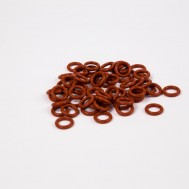Damage during o-ring installation leads to some of the most common causes of o-ring failure. Running into problems such as tearing, twisting and overstretching happen frequently. However, when installed correctly, o-rings will prevent potential leaks and increase the lifespan of the application.
Completing the installation process the right way can save you money, maintenance and time in the future. Here are our five tips for easy o-ring installation.
1. Check Your Sizing
Every o-ring is designed to match specific dimensions. The wrong sizes can lead to serious damage for both the seal and other components. An o-ring that is too small is prone to breakage or tears, while an o-ring that is too large will not adequately seal against fluids or gas. When manufacturing an o-ring, engineers should always administer qualification testing to ensure they are sized correctly and meet the customer’s standards. Check out our O-Ring Gland Calculator to find the right size o-ring for you.
2. Do Not Roll Your O-Ring
O-Rings should always be slid into place, not rolled. Rolling an o-ring during installation can lead to spiraling, which is a common cause of o-ring failure. When spiral failure occurs, the o-ring will get caught on an eccentric component or against the cylinder wall, which causes twisting and 45 degree angle surface cuts. Sliding your o-ring into place will avoid these issues all together. To make this process even easier, make sure your o-ring is well lubricated before sliding.
3. Avoid Overstretching
Every o-ring has a maximum stretch limit. Overstretching your o-ring can cause it to tear or break during installation. When designing and selecting the o-ring for your application, make sure to choose a seal that will stretch just enough to fit the components. The less you stretch your o-ring, the tighter the seal will fit.
4. Look Out for Sharp Edges and Threads
Mating components of the o-ring gland may have sharp edges or threads that the seal must pass over during installation. These threads or sharp edges can easily tear your o-ring. Sometimes, the tears are so miniscule that they can be hard to notice, which will ultimately result in a leaky seal. To avoid damage from threads, cover them with masking tape during installation. Try to avoid sharp edges when possible. If you do run into sharp mating components, lubrication should help your seal carefully slide into place.
5. Use the Right Lubrication
Lubrication will help reduce surface friction and create a smooth transition for installation. However, not all lubricants are the same. There are a variety of different lubrication formulations available to choose from depending on your sealing material and application. Be aware of the possible risks associated with certain products. Some petroleum based lubricants can cause o-rings to swell or dry out. Soap and water is commonly used, however it often provides inconsistent lubrication and may reactivate when wet, which could lead to sealing issues. Make sure that the lubricant you choose is compatible with your o-ring material to avoid shrinkage or swelling. Check out our Chemical Compatibility Guide to learn more.
Have questions about o-ring installation?
Contact an engineer today.
